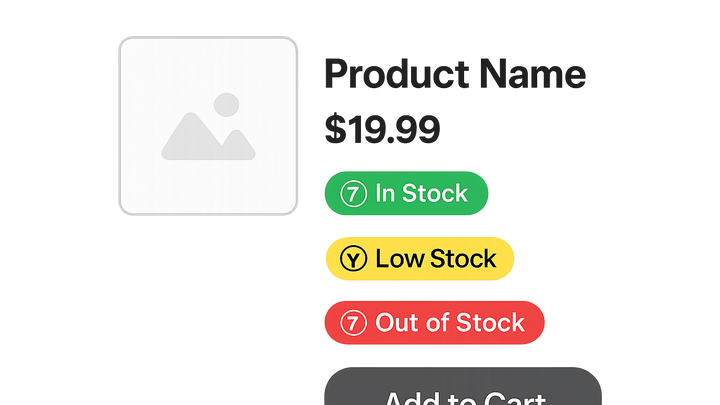Published on 2025-06-29T21:17:16Z
What is Stock Availability? Examples for Stock Availability
Stock Availability refers to the display of a product’s present inventory status on an e-commerce
website or digital storefront. It informs users if an item is In Stock,
Low Stock, or Out of Stock, impacting buying decisions. Clear and accurate stock
information enhances user trust, reduces friction in the purchase process, and can drive urgency through
scarcity marketing tactics.
From a CRO (Conversion Rate Optimization) perspective, timely stock updates can reduce cart abandonment and increase conversion rates. In terms of UX, intuitive stock indicators prevent user frustration, while proper SEO implementation of stock status via schema.org/JSON-LD can unlock rich snippets and improve search visibility. Accessibility considerations, such as screen reader compatibility and color contrast, ensure all users can understand stock information. Tools like Prevue.me can audit your stock availability presentation and offer actionable insights to maximize lead generation and optimize CRO, SEO, UX, and accessibility.
Stock availability
Display of product inventory status on e-commerce sites to boost conversion, UX, SEO, and accessibility.
Why Stock Availability Matters
Stock Availability plays a critical role in guiding user behavior and optimizing site performance across CRO, UX, and SEO. This section explores its impact on conversions, trust, and search visibility.
-
Conversion rates
Visible and accurate stock information directly influences purchase decisions by creating urgency or reassuring availability.
- In-stock:
Signals immediate availability, encouraging users to complete the purchase quickly.
- Low stock:
Highlights scarcity (e.g., ‘Only 3 left’), driving impulse buys through fear of missing out (FOMO).
- Out-of-stock:
Enables back-in-stock notifications to capture leads and maintain customer interest.
- In-stock:
-
User trust and experience
Consistent and clear stock indicators build credibility and reduce frustration in the shopping process.
- Clear visual indicators:
Use badges, color-coded labels, or icons to make stock status immediately recognizable.
- Accessible labels:
Implement ARIA attributes and ensure color contrast for screen reader users and those with visual impairments.
- Clear visual indicators:
-
Seo and schema markup
Properly marking up stock availability with schema.org/JSON-LD can generate rich snippets and improve click-through rates from search results.
- Schema.org markup:
Include the
availabilityproperty within your product schema to inform search engines about stock status. - Json-ld implementation:
Embed a
<script type="application/ld+json">snippet to dynamically reflect live inventory data.
- Schema.org markup:
Optimizing Stock Availability Display
Implement best practices to ensure stock status is prominent, up-to-date, and user-friendly. Use tools like prevue.me for actionable critiques.
-
Prominent placement
Position stock indicators near the Add-to-Cart button or product title to ensure visibility at a glance.
-
Real-time updates
Sync with your inventory management system or API to reflect live availability and avoid overselling.
-
Visual design and clarity
Use high-contrast colors, intuitive icons, and consistent typography to make stock information stand out.
-
Fallback strategies
Provide a ‘Check Availability’ link or default messaging if real-time data fails to load.
Common Mistakes and Pitfalls
Avoid these frequent errors that can undermine stock availability effectiveness and user trust.
-
Outdated inventory info
Failing to sync inventory causes discrepancies, leading to overselling or disappointed customers.
-
Hiding out-of-stock status
Omitting OOS labels disrupts user expectations and can increase bounce rates when items are suddenly unavailable at checkout.
-
Ignoring schema markup
Missing structured data prevents search engines from displaying rich availability snippets, reducing search presence.
-
Poor accessibility
Neglecting ARIA roles or low color contrast excludes users with disabilities from understanding stock status.
Tools and Integrations
Leverage specialized tools and platform integrations to automate and enhance stock availability management.
-
Prevue.me
A SaaS platform offering CRO, UX, SEO, and accessibility audits. It provides actionable critiques to optimize stock displays for higher lead generation.
- Cro recommendations:
Insights on placement, messaging, and scarcity tactics to maximize conversions.
- Accessibility checks:
Audits color contrast and ARIA labeling to ensure stock status is screen-reader friendly.
- Cro recommendations:
-
Shopify inventory api
Sync your online store stock levels in real-time to display accurate availability.
-
Google merchant center
Automate availability updates for Shopping ads and free listings, ensuring shoppers see the latest stock status.
Measuring Impact and KPIs
Track key metrics to gauge the effectiveness of your stock availability presentations and optimizations.
-
Conversion rate
Monitor changes in purchase completion rates after refining stock displays.
-
Bounce rate
Assess if unclear stock information is causing users to leave the site prematurely.
-
Rich snippet impressions
Use Google Search Console to track how often rich availability snippets appear in search results.
-
Back-in-stock signups
Measure newsletter or notification signups as an indicator of ongoing demand for out-of-stock items.
